Type 1 Diabetes in Children
Medically reviewed by Drugs.com. Last updated on May 6, 2024.
Type 1 diabetes is a disease that affects how your child's body makes insulin and uses glucose (sugar). Normally, when the blood sugar level increases, the pancreas makes more insulin. Insulin helps move sugar out of the blood so it can be used for energy. Type 1 diabetes develops because the immune system destroys cells in the pancreas that make insulin. The pancreas cannot make enough insulin, so the blood sugar level continues to rise. Type 1 diabetes cannot be cured, but it can be managed.
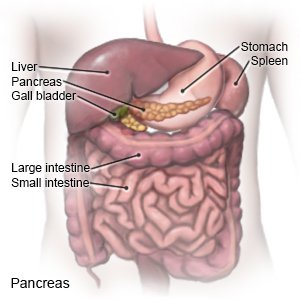 |
DISCHARGE INSTRUCTIONS:
Return to the emergency department if:
- Your child has a low blood sugar level and it does not improve with treatment.
- Your child's blood sugar level is above 240 mg/dL and does not come down after a dose of insulin.
- Your child has ketones in his or her blood or urine.
- Your child has a fever.
- Your child has nausea or is vomiting and cannot keep any food or liquid down.
- Your child has symptoms of a low blood sugar level, such as trouble thinking, sweating, or a pounding heartbeat.
- Your child has blurred or double vision.
- Your child's breath has a fruity, sweet smell, or his or her breathing is deep and labored.
- Your child's heartbeat is fast and weak.
Call your child's doctor or diabetes care team provider if:
- Your child's blood sugar levels are higher than his or her target goals.
- Your child often has low blood sugar levels.
- Your child has abdominal pain, diarrhea, or is vomiting.
- Your child has numbness in his or her arms or legs.
- Your child has warm, red patches of skin or a wound that does not heal.
- Your child is anxious or depressed.
- You have questions or concerns about your child's condition or care.
Medicines:
- Your child will need insulin each day. Insulin can be injected or given through an insulin pump. Ask your child's care team provider which method is best for your child. You and your child will be trained in the best method for him or her. Give your child insulin as directed. Too much insulin may cause his or her blood sugar level to go too low. You will also be taught how to adjust each insulin dose he or she takes with meals. Always check his or her blood sugar level before the meal. The dose will be based on his or her blood sugar level, carbohydrates in the meal, and activity after the meal.
- Give your child's medicine as directed. Contact your child's healthcare provider if you think the medicine is not working as expected. Tell the provider if your child is allergic to any medicine. Keep a current list of the medicines, vitamins, and herbs your child takes. Include the amounts, and when, how, and why they are taken. Bring the list or the medicines in their containers to follow-up visits. Carry your child's medicine list with you in case of an emergency.
Diabetes education:
Diabetes education will start right away. Members of your child's diabetes care team will teach you and your child the following:
- When and how to check your child's blood sugar level: You and your child will learn what his or her blood sugar level should be. You will be given information on when to check your child's blood sugar level. You will learn what to do if his or her level is too high or too low. You may need to check a drop of your child's blood in a glucose test machine. Your child's diabetes care team provider may recommend a continuous glucose monitor (CGM). A CGM is a device that is worn at all times. The CGM checks your child's blood sugar level every 5 minutes. It sends results to an electronic device such as a smart phone.
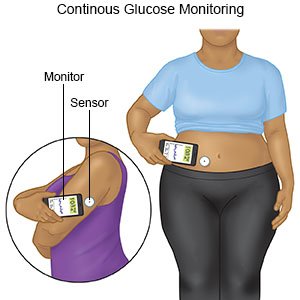
- About how insulin may be given: Your child's diabetes educator will teach you, your child, and your family members about insulin. You will be taught how to draw insulin into a syringe, and how to inject it. You will also be taught the benefits of an insulin pump. An insulin pump is an implanted device that gives your child insulin 24 hours a day. An insulin pump prevents the need for multiple insulin injections in a day. A pump that is connected to a CGM is called an automated insulin delivery (AID) system. You may also be taught how to use an insulin pen. An insulin pen is a device prefilled with the right amount of insulin.
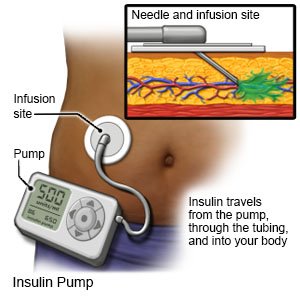
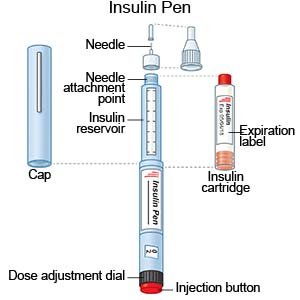
- About nutrition: A dietitian will help you make a meal plan to keep your child's blood sugar level steady. The plan will be made for your child's and family's needs. You and your child will learn how food affects his or her blood sugar levels. You and your child will meet with the dietitian at least 1 time each year.
- About exercise and diabetes: You and your child will learn why physical activity, such as exercise, is important. A plan will be made for your child's activity. A goal of 60 minutes of moderate to intense aerobic activity every day will be in the plan. Your child can choose from activities such as brisk walking, dancing, running, or jumping rope. The provider will also recommend flexibility and resistance training as your child gets older. Your child may need to have a snack before activity to prevent low blood sugar levels. Do not allow exercise if your child's blood sugar level is 350 mg/dL or higher. Your child's level may need to be checked before, during, and after exercise.
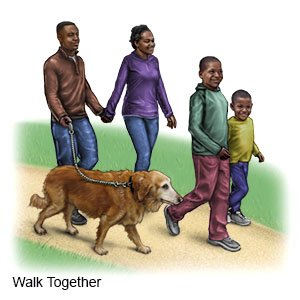

- About complications of diabetes: You and your child will learn about complications, such as diabetic ketoacidosis (DKA), neuropathy, and retinopathy. You will learn how to prevent and recognize some of these complications. You will also learn about conditions that may happen with diabetes, such as high blood pressure and high cholesterol.
Check your child's blood sugar level as directed:
You will need to check your child's blood sugar level 6 to 10 times each day. Ask your child's care team provider when and how often to check during the day. Before meals , your child's blood sugar level should be between 90 and 130 mg/dL. At bedtime , it should be between 90 and 150 mg/dL. You may need to check for ketones in your child's urine or blood if his or her level is higher than directed. Write down the results and show them to your child's provider. The provider may use the results to make changes to your child's medicine, food, or activity schedules.
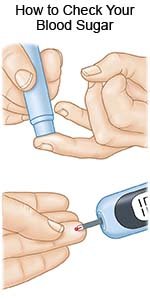 |
Treatment options
The following list of medications are related to or used in the treatment of this condition.
If your child's blood sugar level is too low:
- Your child's blood sugar level is too low if it goes below 70 mg/dL. If the level is too low, have your child eat or drink 15 grams of fast-acting carbohydrate. These are found naturally in fruits and dairy products. Fast-acting carbohydrates will raise your child's blood sugar level quickly. Examples of 15 grams of fast-acting carbohydrate include the following:
- 4 ounces (½ cup) of fruit juice or 4 ounces of regular soft drink
- 2 tablespoons of raisins
- A tube of glucagon gel or 3 to 4 glucose tablets
-
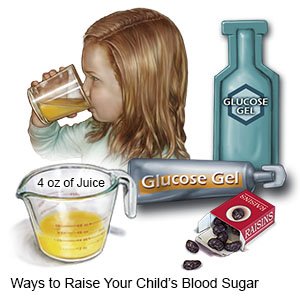
- Check your child's blood sugar level 15 minutes later. If the level is still low (less than 100 mg/dL), give another 15 grams of carbohydrate. When the level returns to 100 mg/dL, have your child eat a snack or meal that contains carbohydrate and protein. This will help prevent another drop in blood sugar. Always carefully follow your child's care team provider's instructions on how to treat low blood sugar levels.
What you need to know about nutrition for your child:
A dietitian will help you and your child create a meal plan. The plan will help keep your child's blood sugar level steady. The plan may change as your child grows and wants different foods. Do not let your child skip meals. Your child's blood sugar level may drop too low if he or she takes insulin and does not eat.
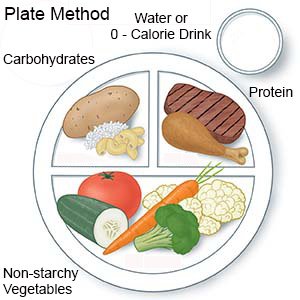 |
- Keep track of carbohydrates (sugar and starchy foods). Your child's blood sugar level can get too high if he or she eats too many carbohydrates. The dietitian will help you plan meals and snacks that have the right amount of carbohydrates.
- Give your child low-fat and low-sodium foods. Examples of low-fat foods are lean meat, fish, skinless chicken or turkey, and low-fat milk. Limit high-sodium foods, such as potato chips and soup. Do not add salt to food you cook. Limit your child's use of table salt.
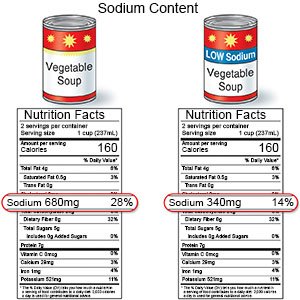
- Give your child high-fiber foods. Foods that are a good source of fiber include vegetables, whole-grain bread, and beans.

More ways to help your child manage type 1 diabetes:
- Talk to your child's care team provider if you or your child become stressed about diabetes care. Learning about diabetes care can be stressful. The stress can cause your child not to want to help in his or her own care. The stress can also cause you to feel overwhelmed. Your child's provider can help by offering tips about self-care. The provider may suggest you and your child talk to a mental health provider. He or she can listen and offer help with self-care issues and feelings of being overwhelmed. You and your child may choose to see the mental health provider at separate times or together.
- Make sure your child always wears medical alert jewelry or carries a card that says he or she has diabetes. Ask your child's provider where to get these items.

- Give instructions to your child's school and care providers. Make sure your child's teachers and care providers know he or she has diabetes. Provide written instructions about what to do if your child has symptoms of high or low blood sugar levels.
- Do not smoke around your child. Do not let others smoke around him or her. Do not let your older child smoke. Nicotine and other chemicals in cigarettes and cigars can cause lung and heart damage. Cigarette smoke can worsen diabetes problems. Ask your child's provider for information if you or your child currently smoke and need help to quit. E-cigarettes or smokeless tobacco still contain nicotine. Talk to the provider before you or your child use these products.
- Get your child's eyes checked as directed. Your child will need an eye exam every 1 to 2 years. The provider will check for changes in your child's sight. He or she will also check for retinopathy (damage to the retina). Your child is at risk for retinopathy when puberty starts and after having type 1 diabetes 5 to 10 years.
- Bring your child in for screenings as directed. Your child will need to be screened for complications of diabetes and other conditions that may develop. Examples include kidney problems, high cholesterol, high blood pressure, blood vessel problems, eye problems, and eating disorders. Some screenings may begin right away and some may happen within the first 5 years of diagnosis. Your child will need to continue screenings through his or her lifetime. Keep your child's follow-up appointments with all providers.
- Ask about vaccines your child may need. Your child has a higher risk for serious illness if he or she gets the flu, COVID-19, or pneumonia. Ask if your child should get vaccines to prevent these or other diseases, and when to get the vaccines.
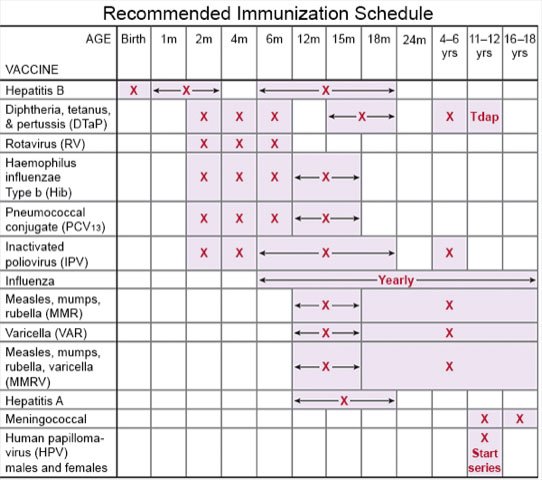
Follow up with your child's doctor or diabetes care team provider as directed:
Your child may need to return every 3 months. Your child's A1c, blood pressure, cholesterol, eyes, and feet will be checked. Write down any questions you and your child have so you remember to ask them during your visits.
© Copyright Merative 2024 Information is for End User's use only and may not be sold, redistributed or otherwise used for commercial purposes.
The above information is an educational aid only. It is not intended as medical advice for individual conditions or treatments. Talk to your doctor, nurse or pharmacist before following any medical regimen to see if it is safe and effective for you.
Learn more about Type 1 Diabetes
- Diabetes Medications and Alcohol Interactions
- OneTouch Blood Glucose Meters
- Top 10 Diabetes Treatments You May Have Missed
Treatment options
Care guides
- Diabetes and your Skin
- Diabetic Hyperglycemia
- How to Draw Up Insulin
- Type 1 Diabetes in Adults: New Diagnosis
- Type 1 Diabetes in Children
Symptoms and treatments
Medicine.com guides (external)
Further information
Always consult your healthcare provider to ensure the information displayed on this page applies to your personal circumstances.
